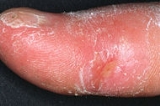
Sclerodactyly
Encyclopedia
Sclerodactyly is a localized thickening and tightness of the skin of the finger
s or toe
s. Sclerodactyly is commonly accompanied by atrophy
of the underlying soft tissues.
The term "sclerodactyly" is made up from the Greek
"skleros" meaning hard and "daktylos" meaning a finger or toe – "hard fingers or toes".
It is sometimes associated with scleroderma
and mixed connective tissue disease
, auto-immune disorders.
Sclerodactyly is a component of the CREST
variant of scleroderma (CREST is an acronym that stands for calcinosis
, Raynaud's phenomenon
, esophageal dysmotility
, sclerodactyly, and telangiectasia
.)
Finger
A finger is a limb of the human body and a type of digit, an organ of manipulation and sensation found in the hands of humans and other primates....
s or toe
Toe
Toes are the digits of the foot of a tetrapod. Animal species such as cats that walk on their toes are described as being digitigrade. Humans, and other animals that walk on the soles of their feet, are described as being plantigrade; unguligrade animals are those that walk on hooves at the tips of...
s. Sclerodactyly is commonly accompanied by atrophy
Atrophy
Atrophy is the partial or complete wasting away of a part of the body. Causes of atrophy include mutations , poor nourishment, poor circulation, loss of hormonal support, loss of nerve supply to the target organ, disuse or lack of exercise or disease intrinsic to the tissue itself...
of the underlying soft tissues.
The term "sclerodactyly" is made up from the Greek
Greek language
Greek is an independent branch of the Indo-European family of languages. Native to the southern Balkans, it has the longest documented history of any Indo-European language, spanning 34 centuries of written records. Its writing system has been the Greek alphabet for the majority of its history;...
"skleros" meaning hard and "daktylos" meaning a finger or toe – "hard fingers or toes".
It is sometimes associated with scleroderma
Scleroderma
Systemic sclerosis or systemic scleroderma is a systemic autoimmune disease or systemic connective tissue disease that is a subtype of scleroderma.-Skin symptoms:...
and mixed connective tissue disease
Mixed connective tissue disease
In medicine, mixed connective tissue disease , commonly abbreviated as MCTD, is an autoimmune disease, in which the body's defense system attacks itself. It was characterized in 1972....
, auto-immune disorders.
Sclerodactyly is a component of the CREST
CREST syndrome
The limited cutaneous form of systemic scleroderma is often referred to as CREST syndrome. "CREST" is an acronym for the five main features:* Calcinosis* Raynaud's syndrome* Esophageal dysmotility* Sclerodactyly* Telangiectasia...
variant of scleroderma (CREST is an acronym that stands for calcinosis
Calcinosis
-Dystrophic calcification:The most common type of calcinosis is dystrophic calcification. This type of calcification can occur as a response to any soft tissue damage, including that involved in implantation of medical devices.-Metastatic calcification:...
, Raynaud's phenomenon
Raynaud's phenomenon
In medicine, Raynaud's phenomenon is a vasospastic disorder causing discoloration of the fingers, toes, and occasionally other areas. This condition can also cause nails to become brittle with longitudinal ridges. Named for French physician Maurice Raynaud , the phenomenon is believed to be the...
, esophageal dysmotility
Esophageal motility disorder
An esophageal motility disorder is a medical disorder causing difficulty in swallowing, regurgitation of food and a spasm-type pain which can be brought on by an allergic reaction to certain foods and by autoimmune disease affecting the muscles such as myositis.- Anatomy :The tubular esophagus is a...
, sclerodactyly, and telangiectasia
Telangiectasia
Telangiectasias /tɛ.læn.dʒiː'ɛk.teɪ.ʃi:ə/ are small dilated blood vessels near the surface of the skin or mucous membranes, measuring between 0.5 and 1 millimeter in diameter. They can develop anywhere on the body but are commonly seen on the face around the nose, cheeks, and chin...
.)

